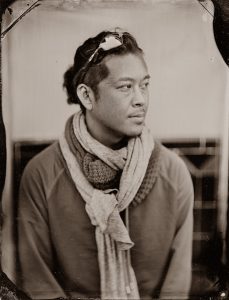
© Anton Orlov 2015
Takashi ARAI / Artist, Filmmaker, Researcher at Tono Culture Research Center
Takashi Arai (1978-) is a Kawasaki / Tono / Berlin based visual artist and filmmaker.
Arai first encountered photography while he was a university student of biology. To trace photography to its origins, he encountered daguerreotype, and after much trial and error, mastered the complex technique. Arai does not see daguerreotype as a nostalgic reproduction of a classical method. Instead, he has made it his medium, finding it a reliable device for storing memory that is far better for recording and transmitting interactions with his subjects than modern photography.
Since the beginning in 2010, when he first became interested in nuclear issues, Arai has used the daguerreotype technique to create individual records—micro-monuments— touch upon the fragmented reality of events in the past. His encounters with surviving crew members, and the salvaged hull, of the fallout-contaminated Daigo Fukuryūmaru fishing boat, led him to photograph the deeply interconnected subjects of Fukushima, Hiroshima, and Nagasaki.
His major projects include Here and There – Tomorrow’s History: documentary-style daguerreotypes created in Fukushima after the triple disasters in 2011, Exposed in a Hundred Suns: the series of historical monuments in the Atomic Age, Tomorrow’s History: teenager’s portraits and interviews collected in historically stigmatized cities, and Daily Daguerreotype Project among others.
Arai’s work has appeared in numerous exhibitions at the Museum of Fine Arts, Boston, Mori Art Museum, Staatliche Kunsthalle Karlsruhe, Modern Museum of Art, Tokyo, among other international venues.
In 2016, Arai received the 41st Kimura Ihei Award for his first monograph, “MONUMENTS” (PGI, 2015). His recent short film, “Oshira Kagami (The Mirror of the Oshira Deity)” won the category prize at the 72nd Salerno International Film Festival in 2018.
Arai’s works are held in the Smithsonian Institution collections, the Museum of Fine Arts, Boston, the National Museum of Modern Art, Tokyo, and Musée Guimet, among others.
Since 2017, Arai has been actively working as a researcher for interdisciplinary studies, such as “Interdisciplinary Studies of Radiation Effects on the Everyday Life of Victims” (National Museum of Ethnology) and “Anima Philosophica: Nature, Disaster, and Animism in Japan” (Institute for Research in Humanities, Kyoto University).
新井卓 (あらいたかし)/ アーティスト、映画作家
1978年神奈川県川崎市生まれ。現在、川崎市、岩手県遠野市、ベルリンの複数拠点で活動する。2014年に英国ソースコード・プライズ(現 The Solas Prize)、2016年には第41回木村伊兵衛写真賞、日本写真協会賞新人賞、神奈川文化賞未来賞を続けて受賞。2018年、映像詩『オシラ鏡』で第72回サレルノ国際映画祭短編映画部門最高賞。
写真の原点を探るうち最初期の写真術・ダゲレオタイプ(銀板写真)を知り、試行錯誤ののち同技法を習得。対象に出会ったときの感覚を、時間と空間を超えて、見るものに生々しく伝えることのできる<小さなモニュメント>として、自身のメディアとしてきた。核の歴史に興味を持ち始めた2010年ごろから、第五福竜丸の船体や元船員に出会い、その後、福島、長崎、広島、と撮るべき対象に自然に巡りあってきた。代表的なシリーズに、福島第一原発事故後の相双地域をドキュメントした「Here and There – 明日の島」、アトミック・エイジの記憶と記念物を巡る「百の太陽に灼かれて/EXPOSED IN A HUNDRED SUNS」、若者のインタビューとポートレイト・シリーズ「明日の歴史」のほか、なるべく毎日撮影をつづける「毎日のダゲレオタイプ・プロジェクト/Daily Daguerreotype Project」などがある。
近年は映画制作、執筆、講演のほか多岐にわたる活動を展開。スミソニアン博物館、ボストン美術館、サンフランシスコ近代美術館、東京国立近代美術館、東京都写真美術館、ギメ美術館ほか多数の美術館に作品が収蔵されている。単著に『MONUMENTS』(PGI、2015)など。2017年から2019年まで、国立民族学博物館館外研究員(放射線影響をめぐる「当事者性」に関する学際的研究)、2019年より遠野文化研究センター研究員。